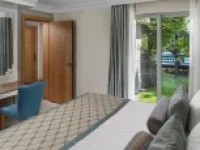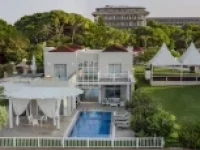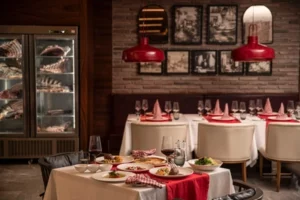ANTALYA: THE PLACE WHERE ALL TRIBES LIVE TOGETHER
Antalya, i.e. Pamphylia (Pan-Phylon) in ancient times. The word means “all tribes”, “The place where people from all tribes live together“.
ANTALYA: A HIDDEN PARADISE
Antalya – where every corner holds an attraction for visitors – is a hidden paradise with a backdrop of the magnificent Taurus Mountains. Just 60 years ago, only people of a certain class were able to reach the coast, via private boats, for sun-drenched holidays. Traders passed through the valleys and mountains on camel, delivering goods such as tobacco and citrus to the port in Kaleiçi. Even today, the passageway through the central Taurus Mountains between Antalya and Konya (Iconium, and the closest neighbouring cities in ancient times) is known among local people as the Giden Gelmez – ‘those who do not return’.
Antalya, or Pamphylia as it was known in antiquity, was a port of refuge for those escaping from war and other difficulties by sea; the area was isolated in ancient times due to the challenges of land transportation through the Taurus Mountains. Pamphylia – the place where different tribes live together – consistently demonstrated an otherwise hard-to-find hospitality in this desolate geography for historic figures ranging from Achaeans defeated in Trojan War to Saint Paul, setting out to spread the word of Christianity after the death of Jesus.
ANTALYA 2018: THE YEAR OF PERGE
Turkey’s Mediterranean coast has provided fertile ground for different cultures, from island pirates to Romans, from Persians to Seljuks and Ottomans. The Antalya region still bears the traces of ancient civilisations, particularly the Roman era. Close to Bebek – home of Papillon Hotel – Perge has emerged at the forefront this year, thanks to is its prominence among the important coastal cities of ancient times, as highlighted in ‘Antalya 2018: The Year of Perge [1]’. In the Bible, it is written that St. Paul and his entourage on their first mission journey came to Pamphylia’s Perge by sailing from Paphos (Southern Cyprus). Although Perge is 15 kilometres from the sea today, in that era, it was a coastal city reachable by sea from the Aksu River. Other evidence suggesting that Perge was a coastal city includes a door, called the Port Gate, opening to the Kestros (Aksu) River from the eastern walls of the city. Perge also features a 300-metre-long colonnaded street, a 12,000 person-capacity theatre, a stadium, and an agora, as well as the Arch of Apollonius Demetrius, a monumental fountain and numerous other finds.
In the scope of ‘Antalya 2018: The Year of Perge’, Perge will host a variety of events during the year. And, in addition to Perge, the region offers the Ancient City of Aspendos, boasting a 12,000 person-capacity Roman-era theatre considered to have the best acoustics of any in the Mediterranean basin, as well as world-famous sites such as Kaleiçi, the historic old city in the centre of Antalya, and monuments such as the Roman-era Hadrian’s Gate. Guests of the Papillon Hotels have numerous opportunities to enrich their holidays with history and culture.
PAPILLON AND THE MAP OF NEARBY ANCIENT CITIES
If you want to add historical ambiance your holiday at the Papillon Zeugma– named for Zeugma, among the world’s most significant ancient sites – at the Papillon Belvil or the Papillon Ayscha, then we look forward to seeing you in Perge, to celebrate Antalya 2018: The Year of Perge! In addition to Perge and Aspendos, we also recommend a hop to Kaleiçi, where you can visit the Antalya Museum and traditional Turkish houses, and see some of the most beautiful works in Turkish-Islamic architecture. Our friends at the Information Desk will be glad to help you design a cultural tour.
HISTORIC SITES IN ANTALYA
Perge:
Perge, showcased this year due to Antalya 2018: The Year of Perge, is the next stop along the route of St. Paul’s journey to spread the word of Christianity. In antiquity, the city featured a port, accessed by the Aksu River. Now about 15 kilometres from the sea within the boundaries of Aksu county, Perge’s highlights include an ancient theatre with a 1,300-person capacity, a bathhouse, a stadium, a monumental fountain and a grand colonnaded road. Just 30 minutes from Belek, the proximity of Perge makes it even more of a must-see.
Aspendos:
Established by Achaeans fleeing to the Antalya region after their defeat in the Trojan War, ancient Aspendos is renowned for its magnificent theatre. With a capacity of 12,000 people, the Roman-era, open-air theatre is still in use today, hosting operas and other events. Many experts believe that Aspendos Theatre has the best acoustics among surviving theatres of its type. As well, Aspendos’ aqueducts – reaching up to a kilometre in length, are powerful tributes to the engineering skills of those ancient designers. Aspendos is about 30 minutes from Belek.
The Antalya Museum:
The Antalya Museum features a total area of 30,000 square meters and 14 exhibition halls, along with an outdoor gallery and a sculpture garden. As one of the most important museums of the world in terms of archaeology and history, an average of 7,000 of the Museum’s 55,000 pieces are exhibited. Halls focusing on the Imperial Family and Emperors, death cults, sarcophagi and the ancient gods bring the present together with magnificent history. The Antalya Museum is in the city centre, about 45 minutes from Belek.
Kaleiçi (Old Town):
A visit to the Kaleiçi section in the Antalya city centre offers stone houses with oriel windows, and beautiful examples of Turkish-Islamic architecture and Roman structures, such as the walls that protected Kaleiçi from invaders. There’s also the Hadrian Gate, the Hıdırlık Tower, and Seljuk-era structures such as the Yivli Minare Mosque (the ‘Fluted Minaret’ Mosque). In his book, “Once Upon a Time in Antalya”, Burhanettin Onat notes that a renowned German architect visited multi-functional courtyards featuring mosaics in black and white geometric tiles or pebbles; one called ‘Rhodesian Work’, includes double wooden wing doors and sofas under shaded trees. The historic old houses of Kaleiçi, with its bougainvillea and jasmine-frescoed walls, reflect the beauty of the Mediterranean. It is said that no nation on earth has demonstrated the ability to combine architectural need aesthetics as much as the Turks. Kaleiçi is about 40 minutes from Belek.
Termessos:
After seizing the famous port city of Perge during his Eastern expedition, Alexander the Great and his 15,000 soldiers marched to Termessos. Established by the Anatolian tribes living among the rocks at altitudes of 1,150 metres, Termessos sat atop today’s Güllük Mountain and was accessed through a very narrow valley. The Solym people, with justifiable pride in their city’s ability to repel invaders, indeed did not allow Alexander’s troops to enter Termessos. Termessos is one of just two cities that Alexander the Great failed to conquer (the other was Sillyon, in Anatolia). With an ancient agora, a theatre, tombstones and six temples, Termessos presents a different sort of splendour nestled among dense mountain pine forests, especially in comparison with most ancient cities, which are generally at sea level.
DID YOU KNOW:
- The mosaics, ‘Gaia’, ‘Achilles’ and ‘Wedding of Dionysus’, on the floor and back wall of the reception as you enter the Papillon Zeugma lobby, are replicas of the best known mosaics of Zeugma, one of the most important Anatolian cities in ancient times. Zeugma, established at the crossing point of the Euphrates River, was one of the world’s largest cities thanks to its strategic location for trade and its population overtook even that of cities such as Pompeii, Londinium (London) and even Athens. [2]
- The Belek region, where the Papillon Hotels are located, is about 30 minutes from Kaleiçi, in the city centre, and the cities of Perge and Aspendos. The Ancient City of Termessos on the summit of Güllük Mountain can be reached in about 90 minutes.
- Antalya Museum was first established in the Alaaddin Mosque, in Kaleiçi, and then at the Yivli Minare Complex. The Museum was founded in order to prevent looting of historical monuments during the War of Independence. Today, more than 55,000 works reside in the Museum. [3]
- The 500-kilometer road located between Antalya, Perge and Yalvac in the north-east of Eğirdir Lake is walked in honour of St. Paul’s travels in Anatolia. The road takes 27 days to traverse and was originally named after Paul, one of the most important Christian saints.
- The construction of the Aspendos Ancient Theatre, supposed to begin in AD 138, lasted 25 years. The Theatre, still used for performances today, is considered an acoustic masterpiece, and all sounds from the stage can be heard easily even from the top galleries.
- After Termessos, Alexander the Great headed towards Sagalassos, which was established by the Solyms in a mountainous region. He easily seized this city, which was not as well-defended as Termessos, despite the support of warriors from Termessos. The ancient city of Sagalassos is within the borders of Burdur province today and 100 km from Antalya.
REFERENCES
[1] 2018 The Year of Perge in Antalya: https://perge2018.aktob.org.tr/
[2] History of Zeugma: http://www.zeugma.org.tr/geneltarihce.aspx
[3] History of Antalya Museum: http://www.antalyamuzesi.gov.tr/tr/muze-tarihcemiz




























